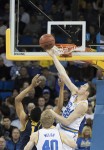After a quick scrimmage period early in Tuesday’s practice, UCLA men’s basketball moved into an intense rebounding drill, with assistant coach Duane Broussard firing up shot after shot as groups of Bruins jostled underneath the glass.
The drill, which featured two squads competing in a series of two-on-two board battles, was aimed at helping shore up an area of UCLA’s game that’s been exposed recently.
“We’ve gone through a stretch here of not handling the backboard very well,” said coach Steve Alford.
On the season, the Bruins’ defensive rebounding percentage is a decent 72.5 percent, a number that places them in the middle of the pack across the nation. But over their first four conference games, that number is around 65 percent, which would rank near the bottom of Division I.
Oregon and Stanford snagged 16 offensive rebounds each against UCLA, and California came down with 17.
The struggles have been especially apparent during UCLA’s slow second halfs. The Bears nabbed 11 offensive rebounds in the latter period of last Thursday’s contest, and the Cardinal snagged nine of their own in the second half on Sunday.
UCLA allows more points on put-backs – 7.1 per game – than any other team in the Pac-12, per Synergy Sports, but the rebounding difficulties have also hurt the Bruins’ offense by robbing them of valuable fast break opportunities.
“If we can do a better job on the backboard, I think you’re going to see our transition game getting faster,” Alford said. “We gave up 16 (offensive rebounds) to Stanford. If 16 becomes eight, that’s eight more opportunities we’re flying in transition off misses, which is our strength.”
[Gallery: UCLA men’s basketball defeats Stanford Cardinal 89-75]
The Bruins’ next opponent could pose problems for them on the backboards.
Though Colorado lacks elite size on the interior, every member of the Buffaloes’ starting lineup measures at least 6 feet 5 inches. And their center, 6-foot-9 Wesley Gordon, plays bigger than his height would suggest, Alford said.
As a result, they rank third in the Pac-12 in scoring on put-backs, per Synergy Sports, generating around seven points a game that way.
Welsh’s Woes
The Bruins’ board troubles have come even as UCLA’s top defensive rebounder, junior center Thomas Welsh, has returned to the lineup.
Welsh, who grabs over a quarter of the available defensive rebounds while he’s on the floor, has been stronger on the offensive glass lately. He’s averaging seven rebounds a game since returning against Oregon, but half of those have been offensive.
Welsh’s jump shot has also been off since his return. Prior to his injury, the big man was connecting on 57.3 percent of his attempts, his mid-range jumpers serving as a reliable part of the UCLA offense.
But in the four games since Welsh came back, he’s shooting just 47.1 percent. In the two games against Cal and Stanford, Welsh went 5-for-18 on jumpers, per Hoop-Math.com.
“I thought the first game against Oregon I played pretty well, but since then, I haven’t really been making shots as well as I would have liked,” Welsh said.
The downtick in efficiency is problematic because jump shots account for over 80 percent of Welsh’s shot attempts. Welsh, though, said he thought it was mostly a matter of shots bouncing the wrong way.
“I have a lot of confidence in my shot, they just haven’t been falling for me as of late,” Welsh said. “My shot’s not always going to be able to fall but if I can do it on the defensive end, I think I’ll have a good game.”
